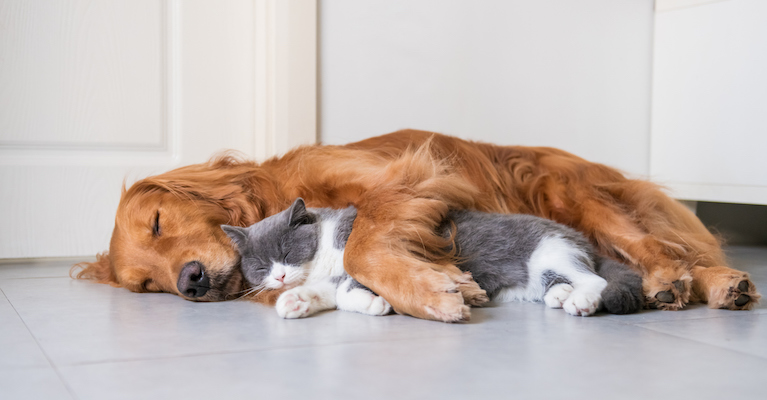
Can you afford to keep a (happy) pet?
How to save money and keep your pet happy!
It is always being said that Britain is a nation of pet lovers, and there is evidence to back this up.
Every year in the UK a Pet Data Report is produced by the PFMA (Pet Food Manufacturers Association). The 2019 report estimates that 40% of households in the UK – around 12 million homes – now have pets. Dogs are the most popular pets (25%) followed by cats (17%). Rabbits, birds, guinea pigs and hamsters are each owned by 1% of the population.
But how much does it cost to have a pet? If you are thinking of getting a pet this is a very important consideration. You need to plan for the one-off costs when you buy a pet then the ongoing costs of keeping one.
These costs can include:
| Initial costs |
Ongoing costs |
- Purchase of pet
- Initial injections
- Microchipping
- Spaying or neutering
- Equipment as needed –
- bed / feeding / crate / litter tray / scratching post / collar & lead / toys etc
- Training/socialisation classes (if applicable)
- Pet passport (if needed)
|
- Food
- Vets bills / pet insurance
- Annual injections
- Flea and worm treatments
- Kennels / catteries / pet sitters
- Grooming
- Toys and treats
|
Lots to think about! So how can you manage to have a pet and still save money?
Here are five ways that can help:
- 1 – Save money in other areas
You can see from the above list that having a pet will incur a lot of expense. It will be a sacrifice, but one that is well worthwhile if you are one of the many pet lovers in the UK. So it’s a good idea to start making sacrifices even before your pet arrives. Why not set up a pet fund? Look at your budget to see where you can start cutting back, and put any money that you save into the pet fund.
You will need to make some lifestyle changes anyway when your pet arrives: for example someone will need to be at home more regularly to feed and care for the pet. So start making changes now and save money as a result.
There are different types of insurance available but the best one for a young animal is lifetime pet insurance. This covers expenses for the life of your pet – eg vet fees, emergency kennels/cattery costs, third party liability cover, dental cover, compensation if your pet is lost or stolen – and may also contribute towards the cost of euthanasia, cremation and burial.
Not surprisingly, pet insurance can be costly. Research by Which? found that the average cost of a lifetime pet insurance policy can cost as much as £472 a year for a dog and £285 for a cat. But it can still be worth getting a lifetime policy because as your pet gets older they are likely to need more care and it may then be even more expensive to try and insure them.
If you decide not to take out pet insurance, it is important to put aside money regularly into an emergency fund so that if your pet does need any expensive vet treatment you are able to meet the costs yourself.
Pet food can be really expensive and once you know what your pet likes to eat, and is good for them, you need to find a way of getting that food as cheaply as possible.
If you’re lucky and the brand your pet likes is stocked by a wholesaler such as CostCo – and you either have or know someone with a card – then you can buy in bulk from there. You can also get good bulk details from pet suppliers such as Pets At Home, who also offer a VIP card which gives you 10% discount plus other special offers. Also look at other online retailers such as Amazon and keep your eyes open for different supermarket offers.
But generally, buying in bulk works out much cheaper so is worth the effort of shopping around and the logistics of finding suitable storage space!
- 4 – Arrange your lifestyle round your pet
If you lead a busy life you can end up having to pay other people to do things that you could do yourself. So when considering having a pet you also need to see if there are lifestyle changes that you can make to save money.
For example, is it possible as a family to slightly rearrange your daily schedules so that there is someone around each lunchtime to walk and feed the dog so that you don’t need to pay someone else to do it? If your pet needs a lot of grooming, would it be worth taking a course to learn how to do it properly rather than paying a small fortune to a pet groomer? And setting aside a little extra time to keep on top of the cleaning – especially if you have a pet that moults a lot – could save you from having to pay a team of house cleaners to come in and sort it all out for you!
- 5 – Share holiday care with a friend
Another major consideration when getting a pet is holidays. You will either need to take your pet with you or find someone to look after it. Kennels and catteries can be very expensive, as can house sitters or cat feeders – which all adds to the cost of the holiday.
So if you are going away without your pet, a great way to save money is to come to an arrangement with a friend, and look after each others’ pets while you are on holiday. Depending on the types of pets you have – and how close together you live – this could range from them dropping into feed the cat, taking your dog to stay with them, or moving into your house while you are away. But whatever the arrangement is, it will ensure that you save money and will also give you peace of mind that your pet is being well cared for while you are away.
So good luck in your quest to have a pet, and we hope that the above information helps you to understand the costs involved and find ways to save money.
Check back here soon for more money saving tips from Loans 2 Go.


 Now is the time to start planning your financial goals for 2026
Now is the time to start planning your financial goals for 2026 
















